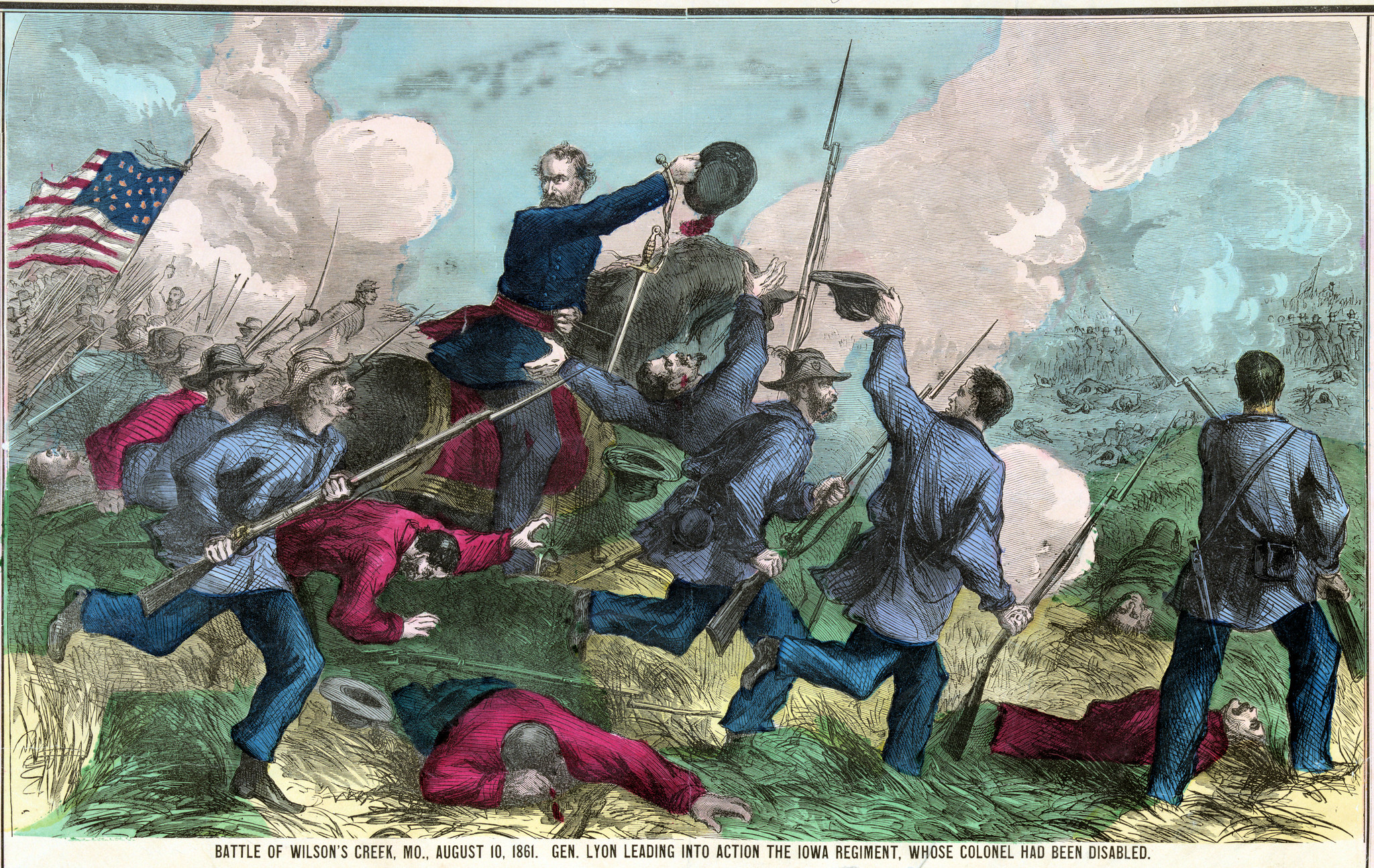 This battle, fought on the 10th of August, was, in some respects, the severest thus far in the present war, and one which, though resulting in the loss of one of our ablest generals, and the subsequent withdrawal of our troops to a position of greater safety, had yet the moral effect of a victory. The facts of the battle, as derived from official sources, were these: Gen. Lyon, finding the Confederate troops assembling in his vicinity in large force, under Gen’ls McCullough, Rains, and Price, and daily receiving re-inforcements, resolved to give them battle before they had time to make the attack they were contemplating. Accordingly, on the 10th of August, he marched out of Springfield with 5,200 men, (900 of whom subsequently re-treated in disorder, and took no part in the fight,) and, soon after sunrise, at a place called Wilson’s Creek, nine miles from Springfield, met and attacked the enemy, who were 23,000 strong. Gen. Sigel was detached to turn the enemy’s flank, while Gen. Lyon and Major Sturgis led up their columns in front. The fight raged from sunrise till one or two o’clock P. M. The Confederate troops charged Capt. Totten’s Battery three times, but each time were repulsed with terrible slaughter. Early in the day, General Lyon was twice wounded, once in the leg, and once in the scalp, but he maintained his position on horse-back, and the Colonel of one of the Iowa regiments having been disabled, and the men offering, he would give them a leader, to charge the enemy with the bayonet, he replied, “my brave boys, I will lead you,” and headed their charge, when he was struck by a bullet in the left breast, and fell from his horse; he was asked if he was much hurt, and replied no, not much,” but soon expired, without a struggle. The other leaders, Gen. Sigel and Major Sturgis, continued the fight until the enemy withdrew, after burning their baggage, to prevent its falling into the hands of our troops. Apprehending that they would endeavor to cut him off from Springfield, Major Sturgis then retreated, in good order, to Springfield, taking as many of his wounded as he could, with him, and the next day, marched with his little force to Rolla, where there were reinforcements. The loss of the Federal troops was 921 killed, wounded, and missing; that of the Confederates, according to their own statement, 517 killed, and 720 wounded, besides prisoners.
This battle, fought on the 10th of August, was, in some respects, the severest thus far in the present war, and one which, though resulting in the loss of one of our ablest generals, and the subsequent withdrawal of our troops to a position of greater safety, had yet the moral effect of a victory. The facts of the battle, as derived from official sources, were these: Gen. Lyon, finding the Confederate troops assembling in his vicinity in large force, under Gen’ls McCullough, Rains, and Price, and daily receiving re-inforcements, resolved to give them battle before they had time to make the attack they were contemplating. Accordingly, on the 10th of August, he marched out of Springfield with 5,200 men, (900 of whom subsequently re-treated in disorder, and took no part in the fight,) and, soon after sunrise, at a place called Wilson’s Creek, nine miles from Springfield, met and attacked the enemy, who were 23,000 strong. Gen. Sigel was detached to turn the enemy’s flank, while Gen. Lyon and Major Sturgis led up their columns in front. The fight raged from sunrise till one or two o’clock P. M. The Confederate troops charged Capt. Totten’s Battery three times, but each time were repulsed with terrible slaughter. Early in the day, General Lyon was twice wounded, once in the leg, and once in the scalp, but he maintained his position on horse-back, and the Colonel of one of the Iowa regiments having been disabled, and the men offering, he would give them a leader, to charge the enemy with the bayonet, he replied, “my brave boys, I will lead you,” and headed their charge, when he was struck by a bullet in the left breast, and fell from his horse; he was asked if he was much hurt, and replied no, not much,” but soon expired, without a struggle. The other leaders, Gen. Sigel and Major Sturgis, continued the fight until the enemy withdrew, after burning their baggage, to prevent its falling into the hands of our troops. Apprehending that they would endeavor to cut him off from Springfield, Major Sturgis then retreated, in good order, to Springfield, taking as many of his wounded as he could, with him, and the next day, marched with his little force to Rolla, where there were reinforcements. The loss of the Federal troops was 921 killed, wounded, and missing; that of the Confederates, according to their own statement, 517 killed, and 720 wounded, besides prisoners.
Battle Scenes, no. 1
published at H.H. Lloyd & Co., c1861
handcolored lithograph
Library of Congress image